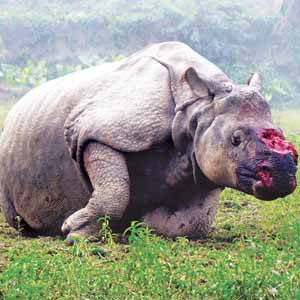Despite a number of scientific studies showing that rhino horn has no curative properties, supermodel, entrepreneur, and recent host of Britain’s Next Top Model, Elle Macpherson, says she ingests powdered rhino horn because: “[it] works for me”. In an interview with The Times Online via Twitter, Elle Macpherson says the illegal substance tastes like “crushed bone and fungus”.
The consumption of rhino horn, which financially underpins illegal poaching, is both the historic and current driver behind rhino decline worldwide, and in the cases of four subspecies: complete extinction.
As well, currently four of the world’s five rhino species are threatened with extinction, three of these species are considered Critically Endangered. There are less than 50 adult Java rhinos in the world and less than 250 adult Sumatran rhinos.
 After having its horn cut off by poachers an Indian rhino slowly dies. Photo by: Bibhab Talukdar of Aaranyak of Assam. Rhinos are usually killed for their horns, which don’t grow back for “re-harvesting”. |
Poaching hit a 15-year-high last year to keep up with demand for rhino horn. Poachers usually shoot or tranquilize the animal before sawing off its horn. Rhinos often die from bleeding to death.
However poaching doesn’t only impact rhinos, rangers who protect them are sometimes in the line of fire: last month a ranger in India was kidnapped by a group of poachers and murdered with two bullets in his stomach.
Powdered rhino horn, such as Elle MacPherson uses, is not cheap: last year one kilo was worth approximately $60,000, nearly $20,000 more than a kilo of gold.
While there have been discussions of legalizing the trade in order to draw down the price of rhino horn and use the proceeds for conservation, for now the sale or purchase of rhino horn products is banned worldwide by the Convention on Trade in Endangered Species (CITES).
Mongabay.com contacted Elle MacPherson’s office for a comment, but did not hear back.
-
Section of interview with Elle MacPherson on rhino horn from The Sunday Times:
Witter: You’re said to be a great fan of Chinese medicine. What does powdered rhino horn taste like?
E MacP: A little bit like crushed bone and fungus in a capsule. Does the job though.
Witter: How do you know that it works? A lot of people say Chinese medicine is quackery.
E MacP: Put it this way, works for me.
Witter: Did you find your nickname “The Body” offensive? Sexist?
E MacP: Brilliant name. I trademarked it and built a business out of it. What part of that is sexist?
Source: Bush Warriors
Related articles
Poachers kidnap and murder ranger in India
(06/14/2010) A forest guard (i.e. ranger) in Orang National Park paid the ultimate price for protecting wildlife last week. Hassan Ali was found with two bullets in his stomach after being kidnapped by four men allegedly connected to poaching operations targetting the park.
Poachers kill world’s rarest rhino in Vietnam
(05/11/2010) Poachers have killed a Javan rhino in Vietnam for its horn according to the World Wildlife Fund (WWF). With only an estimated 60 individuals left the Javan rhino is the world’s rarest and classified by the IUCN Red List as Critically Endangered. The rhino was found dead from a gunshot wound and its horn cut off in Cat Tien National Park in Vietnam.
National parks in India and Nepal hit by rhino poachers
(03/02/2010) The rare Indian rhinoceros is not safe from poachers even in national parks. In Nepal’s world renowned Royal Chitwan National Park, twenty-four Indian rhinos (Rhinoceros unicornis) have been poached since the last census was taken in 2008. The most recent one was killed last Thursday. Approximately 372 Indian rhinos survive in the park, and the population is in decline.
UN official: Zimbabwe security forces poached 200 rhinos
(02/14/2010) Last week the secretary of the UN Convention on International Trade in Endangered Species (CITES), Willem Wijnstekers, announced that security forces in Zimbabwe had poached approximately 200 rhinos in a two year period. He did say how many elephants were poached by security forces.
Gone: a look at extinction over the past decade

(01/03/2010) No one can say with any certainty how many species went extinct from 2000-2009. Because no one knows if the world’s species number 3 million or 30 million, it is impossible to guess how many known species—let alone unknown—may have vanished recently. Species in tropical forests and the world’s oceans are notoriously under-surveyed leaving gaping holes where species can vanish taking all of their secrets—even knowledge of their existence—with them.
Face-to-face with what may be the last of the world’s smallest rhino, the Bornean rhinoceros

(12/01/2009) Nothing can really prepare a person for coming face-to-face with what may be the last of a species. I had known for a week that I would be fortunate enough to meet Tam. I’d heard stories of his gentle demeanor, discussed his current situation with experts, and read everything I could find about this surprising individual. But still, walking up to the pen where Tam stood contentedly pulling leaves from the hands of a local ranger, hearing him snort and whistle, watching as he rattled the bars with his blunted horn, I felt like I was walking into a place I wasn’t meant to be. As though I was treading on his, Tam’s space: entering into a cool deep forest where mud wallows and shadows still linger. This was Tam’s world; or at least it should be.
In midst of poaching crisis, illegal rhino horn tops gold
(11/25/2009) Rhino poaching has hit a fifteen-year high, and the rising price for black-market rhino horn is likely the reason why. For the first time in a decade rhino horn is worth more than gold: a kilo of rhino horn is worth approximately 60,000 US dollars while gold is a little over 40,600 US dollars.
Rhino poaching epidemic underway in South Africa
(09/10/2009) In July national parks in South Africa lost 26 white rhinos and one black rhino to poachers, bringing the total rhinos lost to in South Africa to 84 this year alone. The situation has led Water and Environmental Affairs Minister Buyelwa Sonjica to call for an integrative approach to the crisis.